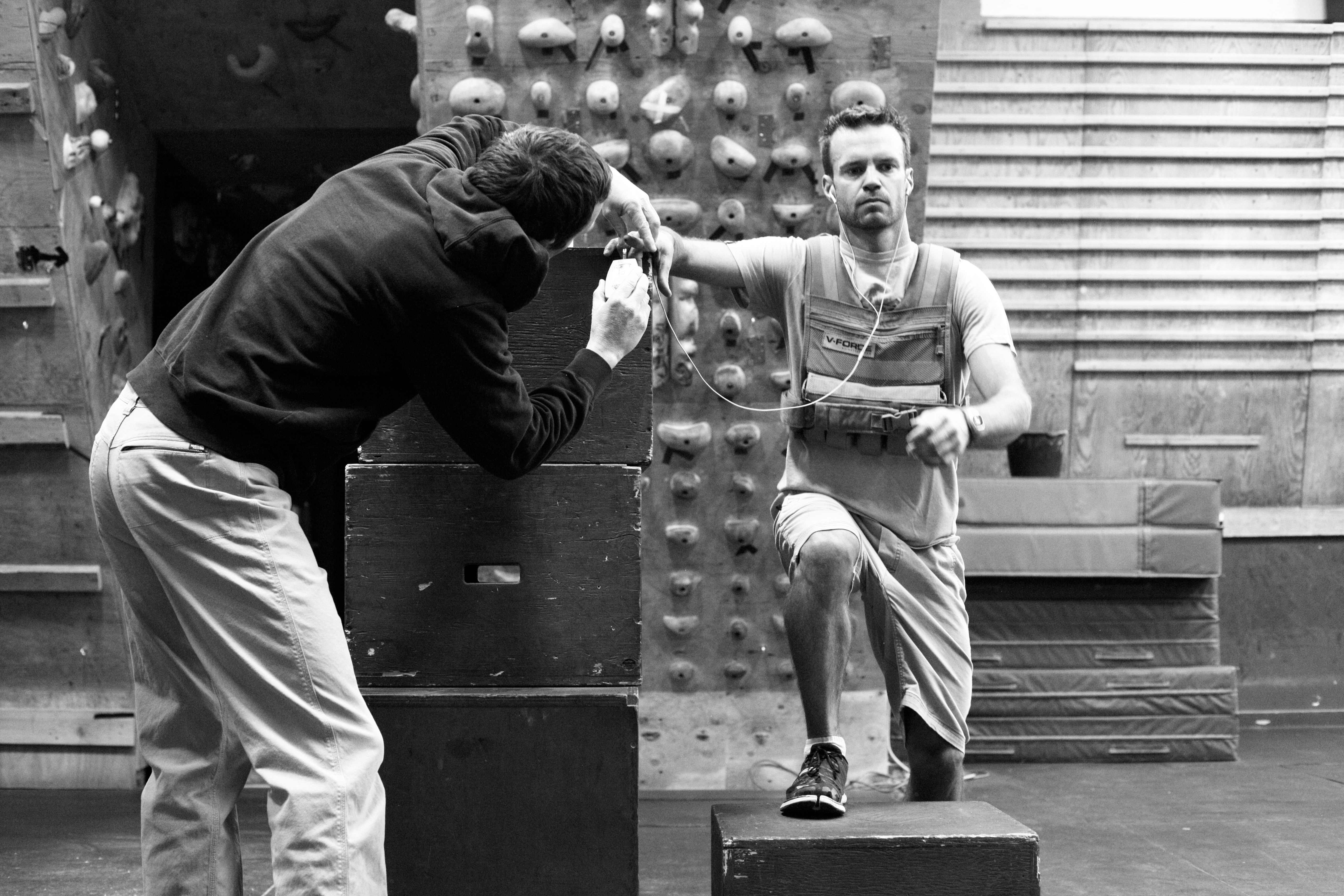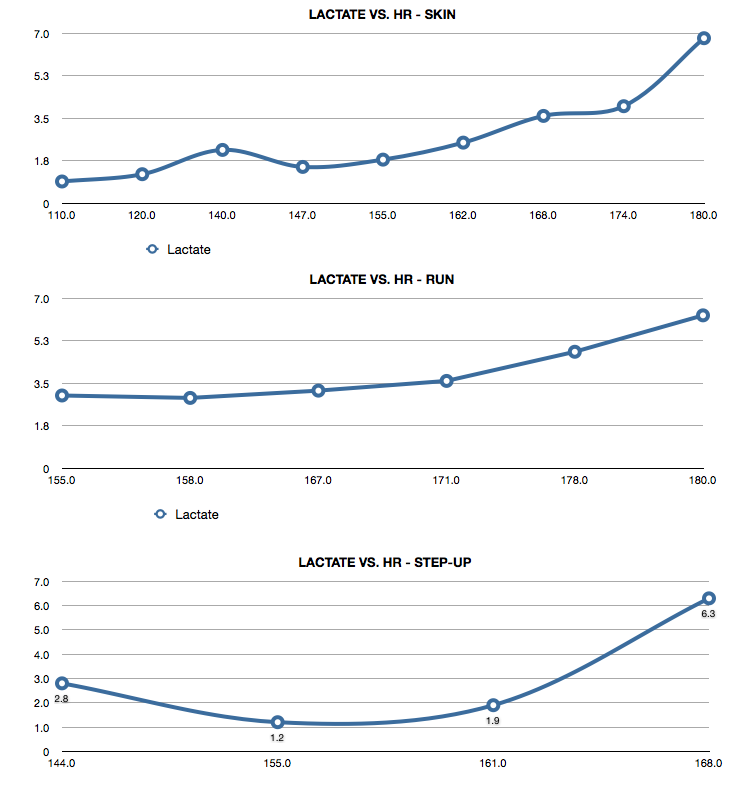Abstract: This was an experiment to test whether athletes display different lactate thresholds (LT), and heart rate levels (HR) in three different mountain sports: mountain running (uphill), ski mountaineering (skinning uphill), and hiking (uphill with weighted pack). All experiments were tested in a controlled gym environment where the subject was on an incline treadmill or doing step-ups on a bench. Studies by others have shown that triathletes exhibit different heart rates and lactate threshold results depending upon the mode of activity (i.e., one study found LT in triathletes differed depending upon whether cycling or running. Athletes maintained higher average HR to lactate level while running, and hit LT at higher HR when running, as compared to cycling. The study concluded that the full-body muscle recruitment required for running caused the elevated HR and difference with LT). We wanted to test if athletes exhibited similar differences in different modes of mountain sports.
Introduction: The theory behind lactate threshold training is that lactate is produced by the anaerobic system and used by the aerobic system; thus, it is the only marker available for measuring both systems. If you learn what your LT is, you use this threshold as the key parameter to monitor your training load. The amount of energy an athlete can produce per unit of time depends on the development of both systems, which is why they have to be balanced. (Essentially this means training the anaerobic system to a level that is appropriate for the athlete’s aerobic capacity.) This balance will depend upon the event for which the athlete is competing and will also depend upon which part of the training cycle the athlete is in. The first part of the training cycle focuses on building as strong an aerobic system as possible. As the athlete gets close to the “big” event, the anaerobic system will have to be “fine-tuned” for a peak performance.
Over time, changes in blood lactate levels tell the coach what physiological adaptation has taken place in each system. They tell the coach which forms of training are working (or not working). Training time becomes much more efficient as the athlete performs only workouts that work. Your LT becomes a training compass that steers each athlete in the right direction. It is much more relevant than heart rate monitoring which reflects a general overall body response to stress and doesn’t necessarily reflect what is happening in the muscles or with the anaerobic system. It is much more versatile than VO2 testing which requires very expensive equipment and requires experts to administrate the test properly and focuses solely on the aerobic system.
We wanted to test these methods and theory on mountain athletes. There are plenty of studies and competitive results by athletes out there proving this theory for other major sports (cycling, running, triathlon, rowing), but not for mountain athletes.
Methods
- Study Population: For the initial test, we used one subject, Ryan Burke (age 32). Burke performed all three tests over a period of one week, taking rest days one-day before each testing day. [*we need to test this on many more athletes].
- Testing Procedure: This experiment and testing protocol was not new to Mountain Athlete. In this test, athlete performed uphill skinning on the treadmill, uphill running on the treadmill, then hiking simulation by doing weighted step-ups (25 lb weight vest, stepping up on 16” bench). Mountain Athlete coaches have performed this test in the past to test an athletes’ LT in order to develop specific training programs and parameters for that individual athlete.
- Protocol & Progression: with all three modes, the athlete performs 15-minute warm-up. HR and lactate are measured at 15-minute mark. Then, every subsequent three minutes, lactate and HR is measured. Incline remains the same throughout progression (~15%). Speed increases 3-mph for the second three-minute interval. Thereafter, each three-minutes, speed increases 2-mph. This progression continues until athlete’s lactate spikes (>4 mM/litre of blood lactate = L), signifying LT has been reached. (see graphs below)
- Day one (Jan. 15, 2015): skinning on incline treadmill (~15% grade).
- Day two (Jan. 19, 2015): running on incline treadmill (~15% grade).
- Day three (Jan. 21, 2015): weighted step-ups (25 lb weight vest) on 16” bench at set tempo (athlete followed tempo set by metronome, getting progressively faster with time, to increase speed). [*this test had holes in it. Lactate testing device read errors on first reading, and then testers ran out of lactate strips so we had to improvise and save strips until athlete reached higher lactate/HR levels].
Results
| SKIN | |||
| Speed | LT Chart | Lactate | HR |
| (MPH) | Time (min) | (BPM) | |
| 1.5 | 15 | 0.9 | 110.0 |
| 1.8 | 18 | 1.2 | 120.0 |
| 2.0 | 21 | 2.2 | 140.0 |
| 2.2 | 24 | 1.5 | 147.0 |
| 2.4 | 27 | 1.8 | 155.0 |
| 2.6 | 30 | 2.5 | 162.0 |
| 2.8 | 33 | 3.6 | 168.0 |
| 3.0 | 36 | 4.0 | 174.0 |
| 3.2 | 39 | 6.8 | 180.0 |
| 3.4 | 42 | ||
| RUN | |||
| Speed | LT Chart | Lactate | HR |
| (MPH) | Time (min) | (BPM) | |
| 3.5 | 15 | 3.0 | 155.0 |
| 3.8 | 18 | 2.9 | 158.0 |
| 4.0 | 21 | 3.2 | 167.0 |
| 4.2 | 24 | 3.6 | 171.0 |
| 4.4 | 27 | 4.8 | 178.0 |
| 4.6 | 30 | 6.3 | 180.0 |
| 4.8 | 33 | ||
| 5.0 | 36 | ||
| 5.2 | 39 | ||
| 5.4 | 42 | ||
| STEP-UP | |||
| Cadence | LT Chart | Lactate | HR |
| (SPM) | Time (min) | (BPM) | |
| 27.0 | 18 | 2.8 | 144.0 |
| 31.0 | 24 | 1.2 | 155.0 |
| 33.0 | 27 | 1.9 | 161.0 |
| 43.0 | 42 | 6.3 | 168.0 |
Discussion/Hypothesis/Next Steps
We need to test this on many more mountain athletes before developing any meaningful or helpful hypothesis. No conclusions can be made after this testing cycle. However, based upon similar studies done with other types of athletes (mainly distance runners, cyclists, triathletes), we can make the following hypotheses:
- Generally, athlete’s LT (when 4 mM/Litre of lactate was reached) was found to be in tight range between all three modes of work: HR= ~171-175. However, athlete’s HR levels displayed interesting difference between modes. With the uphill run, there was a much higher lactate/HR relationship, as compared to the skin. Running may allow more anaerobic work p/HR without causing metabolic failure. The eccentric muscle functioning in the running mode could cause this.
- The similarity in LT between all three modes tested may also be due to the fact that the different mountain “modes” tested here are not actually very different; they are all forward plane movements (one foot in front of the other. No lateral movement). The similarity of movement patterns may account for the similarity of LT, as compared to other studies (ie, triathletes, rowers) where different modes truly engage body movements along different planes and engage different muscle groups.
- With step-ups (simulating uphill hiking in mountains) we loaded the athlete with 25 lb weight vest. We did not load athlete in other modes. With step-ups, the athlete was not able to maintain higher-end HR with increased pace, as he was able to in other modes (skinning, running). The hypothesis is that with weight, athlete reached muscle fatigue sooner, causing inability to maintain higher aerobic output. Despite testing glitches, the athlete still seemed to hit his LT in generally same HR range (~175), as with other modes. Thus, weighing an athlete may affect HR/LT more than what mode of sports the athlete is in.
- For the athlete in this study, and his learning/training, the results also show that he may be undertrained aerobically. Because the athlete was able to reach higher HR quickly and maintain this effort level for longer without hitting LT as quickly, generally indicates that the athlete’s anaerobic system is kicking in sooner to allow this functioning. The athlete in this study may have stronger anaerobic work capacity at this point in his training and decreased aerobic work capacity. In such a case, an athlete’s system is relying on glucose for ATP energy production rather than his aerobic system (O2). Thus, in designing a training system to better develop his endurance for longer slower aerobic efforts in the mountains, coaching would suggest he train long efforts and maintain a reduced HR (65-75% of LT HR) to better train his aerobic system. The goal is creating a more powerful and efficient athlete while maintaining same HR for that effort level (output). In theory, eventual training of the aerobic system with essentially balance out the aerobic-anaerobic functioning for this athlete, thus allowing the athlete to move more powerfully and efficiently at lower HR for longer without hitting LT as quickly.
- Next steps: Test whether loading of the athlete during step-ups was major influencing factor in lower HR and muscle fatigue. Perform next set of test with skinning uphill on treadmill and running uphill on treadmill both with loaded weight vest. Then, test step-ups unloaded.
You Might Also Like: The Alpinist Fitness Assessment


